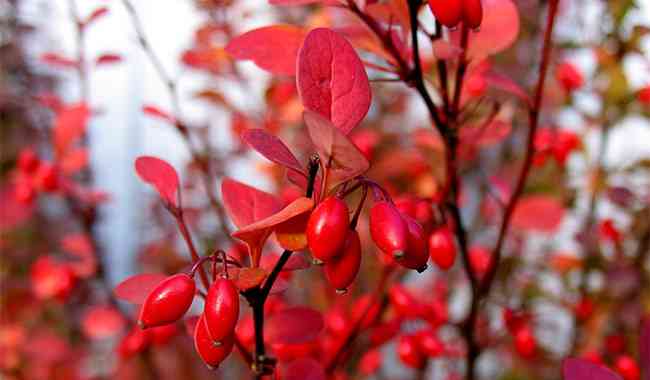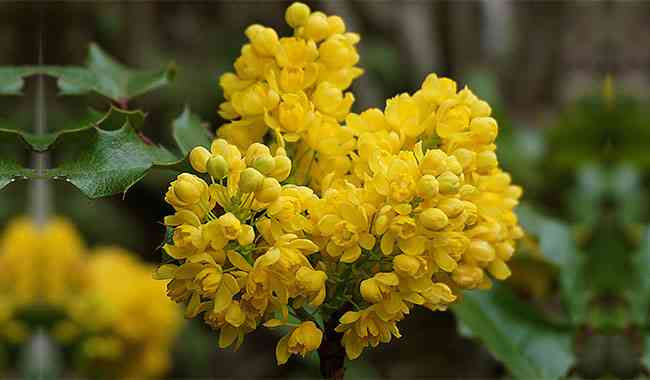
The designers saw the barberry bush as a jewel in the decor. Some 175 species and more than 500 varieties offer the opportunity to transform a dull landscape into a wonderful world of unusual colors and shades and to transform terraces and slopes into a magical fairy tale. Ornamental shrubs, huge and dwarf, evergreen and deciduous, with skeletonized or lush foliage of different colors and shades – from green to red, burgundy, yellow, fringed, spotted – are used in decorative horticulture in urban parks and their zoning.
Barberry bush with variegated foliage looks great when planted singly or mixed with prickly trees, conifers, cotoneaster, and other ornamental crops.
Single species of low shrubs are unique in mixed borders, and dwarf shrubs are great in bedding plantings. Their foliage combined with small clusters of ornate berries, umbels, and other inflorescences add a special charm.
The wide variety of species and varieties, their rich chemical composition, and biological characteristics allow you to use barberry bush.
- An ornamental crop that forms a hedge or landscape
- A valuable fruit plant.
- A folk remedy for many diseases.
- Food used in cooking.
A BRIEF DESCRIPTION OF THE VARIETIES OF BARBERRY BUSH
Of all the barberry (Berberis) species, the main ones used are the common barberry, B. darwinii, B. dictyophylla, B. julianae, B. thunbergii, and B. verruculosa. Each has its own characteristics in terms of bush height, crown shape, foliage color, flower and fruit color, and resistance to the environment.
The red-leaved barberry bush is suitable for garden decoration. It features highly decorative, curved, ribbed scarlet-red shoots and is often used in southern regions to form hedges for summer houses and patios. The shoots are covered with flexible prickles. Some barberry bushes are not frosted tolerant. Ranging in height from 1.5-5foot (0.5-1.5 m), the shrubs decorate yards and gardens well, providing individuality to decorative groups and solo plants with distinctive foliage colors – bright green in summer and fiery red in autumn. The axils have 2-3 small bunches of inedible but medicinal red fruits. Ripens in September-October.
The common Berberis vulgaris is very spiny. The long, slender prickles are arranged along the entire stem. It can be used as a fruiting shrub for country houses and also for making hedges. Its fruit has a distinctive sour taste and is a popular fruit snack in northern regions.
It has a strong and pleasant fragrance that attracts bees. Barberry bush honey can be used in medicine. Like its predecessors, the berries ripen in September/October. They hang in handsome clusters of bright red. Common Bordeaux mixture is frost and drought tolerant and requires little care, but is not suitable for site decoration (to combine the two).
Among the evergreens, the red-leaved barberry bush, up to 10 feet (3 meters) tall, with dark green leaves, is attractive and looks good in the landscape. The latter is not frosted tolerant and is therefore mainly recommended for southern regions.
The most striking is the red-leaved barberry bush and the rosary barberry bush. Low shrubs, scattered, only 12-20inch (30-50cm) tall, evergreen, orange and yellow flowers and blue fruit – good in summer and an attractive accent to the winter landscape.
Barberry bush (Berberis x ottawensis) is known for its unusually colorful foliage. It has purple foliage in the summer that turns yellow and red in the fall. The hybrid is characterized by large berries. The stinging sensation is negligible.
As an ornamental foliage crop, barberry bush can be cultivated in sunny woodlands and shady locations. The variegated foliage changes color as the light changes but remains magnificent and bright. Barberry bush attracts the attention of gardeners and lovers of bright personalities in trellis and garden plant design for this feature as an ornamental shrub.
THERAPEUTIC PROPERTIES OF BARBERRY BUSH
For therapeutic purposes, folk healers use decoctions and infusions of all parts of the culture (berries, leaves, bark, roots) to treat the liver, kidneys, digestive tract, and fevers.
Official medicine recognizes the therapeutic properties of barberry bush in cleansing the blood, reducing the vulnerability of blood vessels, and as a preventive measure to reduce the risk of malignant tumors. All parts of the crop have hemostatic properties. Barberry bush leaves, collected after the plant has flowered, and young bark – in the autumn season – are good at suppressing inflammation and have diuretic and hemostatic properties. The decoction of the root lowers blood pressure, has a positive effect on rheumatism and cholelithiasis.
The barberry bush plant has contraindications for use as a medicine. A medical consultation is required.

USING BARBERRY BUSH IN COOKING
The berries of the edible variety of barberry bush are used to prepare jams, marmalades, marmalades, tea additives, condiments for second courses. The juice of the berries, boiled with sugar, is an excellent remedy for acute colds and can be used as an antipyretic.
The barberry bush sauce used in meat and fish dishes has an unusual flavor. Berries are used to make rich Liqueur or Spirit, fruit drinks, natural vinegar. Dried fruits and dried berries can replace lemon in terms of vitamin C content in tea.
GROWING BARBERRY BUSH
barberry bush can be easily grown in the garden. With such a long list of valuable characteristics, it will not cause annoying care but will constantly delight with its condiments, fruits, and winter preserves.
Requirements and soil preparation
Barberry bush will grow on any type of soil. Depending on the variety, they can live in full sun or shade. They do not tolerate standing water and prefer dry soil.
In order for them to root quickly and start growing and developing, prepare a planting hole 3-4 times larger than the seedling’s root system, with an average size of 20x20x20inch (50x50x50 cm).
Pour a bucket of water into the prepared planting hole. Wait until it soaks into the soil and then proceeds to lay the drainage system. The drainage system consists of gravel, pebbles, and sand in layers 6x8x10inch (15-20-25 cm) high, depending on the precipitation in the area. The remaining space is filled with a mixture of soil with humus and peat (if available). To each bucket of the mixture, add one cup of ash, 3-4 tablespoons of lime or dolomite (lime powder), 50-60 grams of calcium superphosphate, and 20-30 grams of potash. The same amount of mineral fertilizer can be replaced by nitroglycerin, other complete fertilizers.
How to grow barberry bush
It is better to plant barberry bush in spring so that during the summer period, the small bush will strengthen, form a root system and take root in new environmental conditions. In warmer areas, the crop can be planted in the fall with the same success.
Barberry bush can be planted as individual shrubs in a hole or as several plants in a row, leaving 8-10inch (20-25 cm) between plants (for hedging).
Place the sapling in the center of the planting hole so that the root neck is 1-2inch (2.5-5 cm) below the soil level and add the prepared soil mixture to the soil level. Root buds are located at the neck of the plant. These shoots will produce new shoots if frost occurs in the above-ground part of the shrub. Water the planted seedlings (half a bucket of water) and covered them with leaves, sawdust, and other fine ground covers.
Care of barberry bush
Care of barberry bush includes hoeing to kill weeds, watering, fertilizing, pruning, and crown formation.
Fertilization of barberry bush
Fertilization begins in the second year of life. Apply 30-40 grams of urea diluted in a bucket of water under the bush. For the next 2-3 years, fertilize in the spring until the buds bloom or apply nitro-phosphorus or nitro-ammonia-phosphorus and other complex fertilizers containing trace elements before flowering. You can simply add micronutrients to the basic fertilizer. Apply fertilizer under irrigation or as a solution. Fertilize mature barberry bush bushes every 3-4 years.
Watering
Young plants can be watered 1-2 times per week to support the young root system. As it develops, watering decreases to once every 10-15-30 days. Shrubs can tolerate brief periods of drought. When the soil loses its moist state to the depth of the palm of your hand, the next watering can take place. In rainy years, the crop will not be watered. A dry year is better for barberry bush than a wet year with stagnant water at the roots.
Pruning
Pruning of Bordeaux mixture is done every year. In spring, sanitary pruning is usually done. Remove diseased, dry, bent, and inward-growing shoots. Ensure that the hedge is thinned so that the remaining shoots can develop properly. Thinning and maintenance pruning of acacias is carried out in June and August. This is necessary in order to maintain the initial shape of the hedge.
Propagation of barberry bush
Barberry bush is propagated asexually and by seed. It is most commonly propagated asexually by cuttings and grafting in the same way as gooseberries and currants.
Protection against diseases and pests
The main pests of the bush are the acacia aphid, flower moth, acacia moth, and acacia sawfly. It is not recommended to treat plants with chemical agents. Nowadays, the chemical industry offers a wide range of biological agents that are harmless to humans and animals. These products can be used until the time of harvest. Biological agents for the control of the above-mentioned pests are Fitoverm and others. Plants should be treated according to the recommendations. Otherwise, the desired effect will not be achieved.
Barberry bush is susceptible to powdery mildew and rust. These fungal infections can also be cured relatively easily with bio fungicides if the treatment is carried out as recommended.
The best known biological agents used to control rust, and powdery mildew is myclobutanil and others. The bushes can be sprayed with Bordeaux mixture 1% before germination and after harvest.
More related information about growing barberry bush



